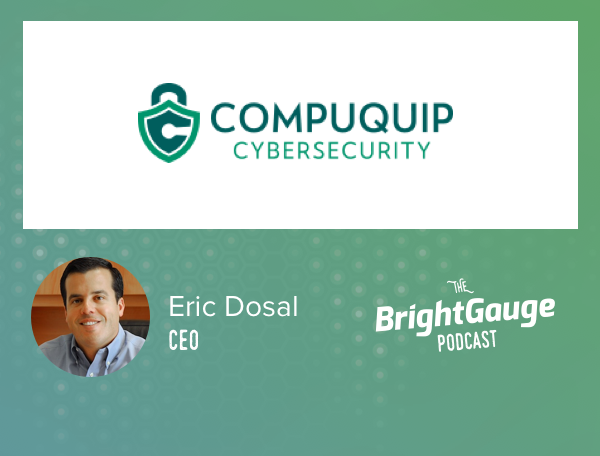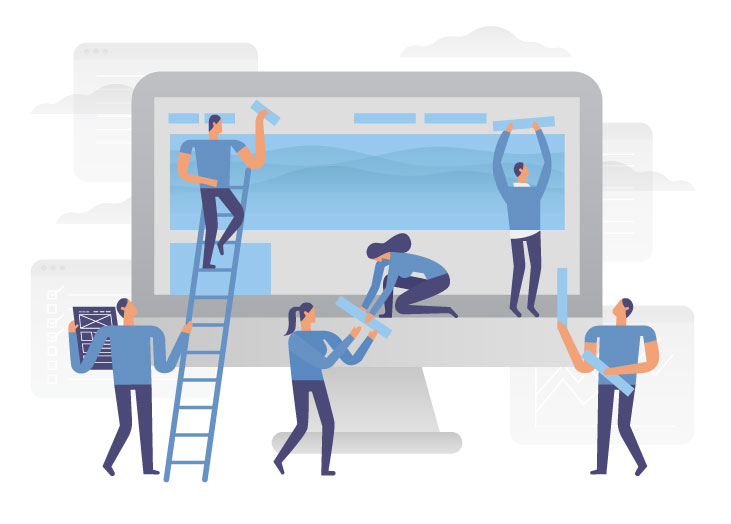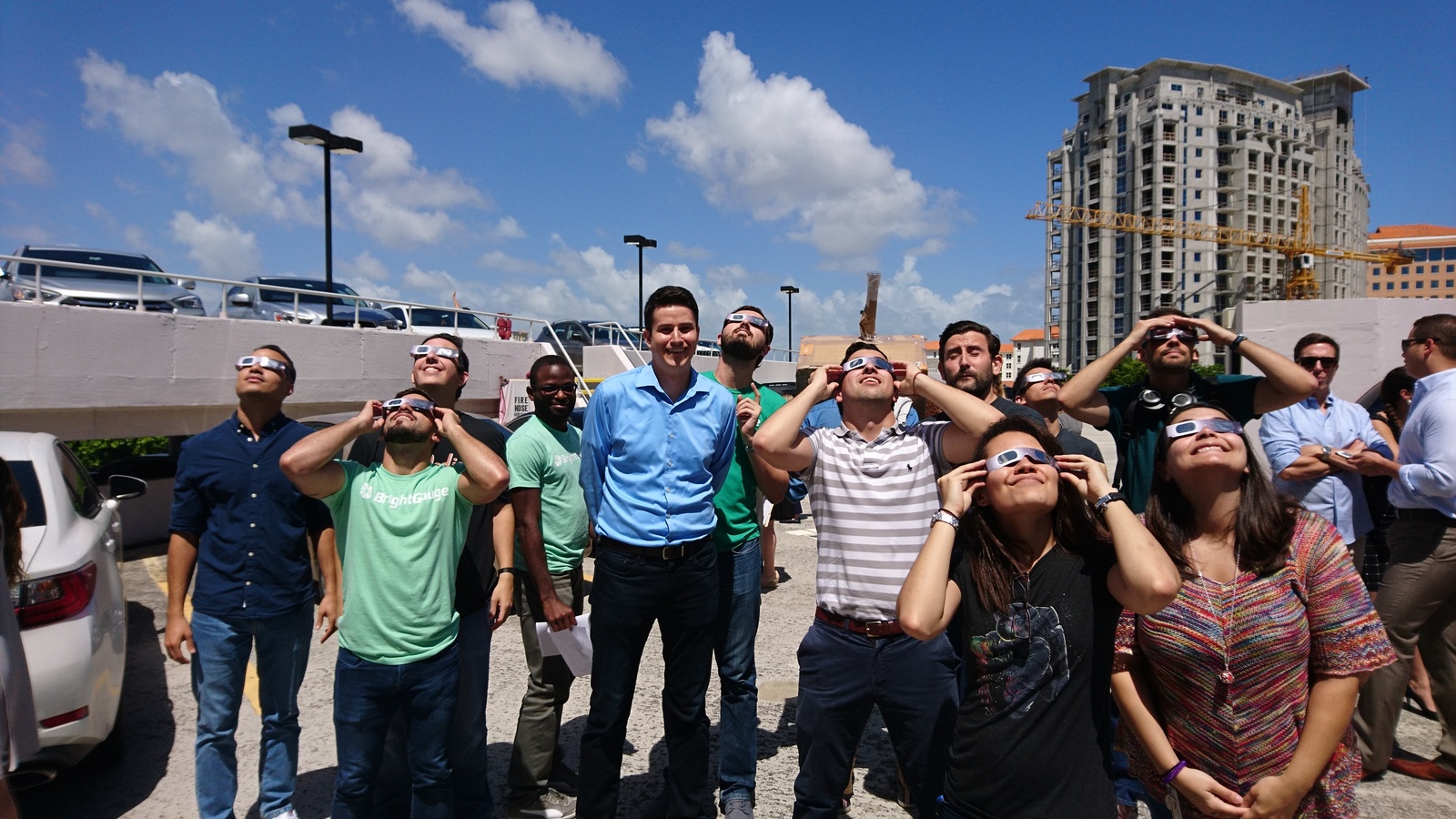
A welcome back to the BrightGauge podcast! This month the tables turn as cofounders Brian and Eric Dosal interview each other on the last year at BrightGauge & Compuquip. Make sure that you're not only implementing the tool but you're also helping the customer monitor it. Top episode takeaways: Part 1 Brian Dosal steps up as the CEO of BrightGauge as Eric Dosal transitions to CEO of their family business, Compuquip Cybersecurity. The history behind Compuquip, what’s planned for growth The new urgency of cybersecurity Part 2 [skip to 28:28] Where BrightGauge stands today Time management and the Basecamp approach How to keep up with what’s new at BrightGauge & Compuquip Cybersecurity _____________ Transcript: Brian: Yes. They got a lot of listens, and this year I want to bring them back out, so this is our kickoff one, so you're the special guest if you will. And we took about a five-month hiatus, and that's really what we want to dive into here. With the big kind of starting point with that hiatus is the transition of CEOs, so this past summer you transitioned the CEO duties of BrightGauge to me, and that reason was to jump back into the family business in Compuquip. So give us the background, not just on that transition but even what Compuquip is, some people might have no idea, probably don't even know that we’re transitioning CEO right now, so this could be new. The History Behind Compuquip Eric: Breaking news here, so Compuquip is a family business that our father and mother started in 1980, equipment leasing back then, and over 30 years morphed into networking and IT support. In 2002 we saw the power of the internet and we decided to invest in securing that internet, and so we brought on a team that specialized in, at the time it was internet security which is now cyber security. And so if you fast-forward from 2002, that's when I also joined full-time and I focused on our legacy infrastructure break fix project business. And when you joined in 2005 we took that business and grew it quite a bit, and then we saw the opportunity to transition into a mainly service provider. So in 2007, launched our MSP, and we grew from the 800,000 revenue head at a time to a little over 8.8 million, so 11x growth in five years, and we were very successful in selling that business when we saw the opportunity that we had at BrightGauge, because we started BrightGauge in the middle of that. So now my focus at Compuquip, because Compuquip has continued to grow and really been solely focus on cyber security, is taking it to the next level because we have a great team, we have three current sales people, we got a team of about 15 engineers, we cover the entire state of Florida and we are moving to the southeast, but we see this huge opportunity in cyber security. And we needed someone that was really going to lead it, and we sat around the family table and talked about who's the best person to do it; it just made sense for me to take that jump. Brian: And it's a good history. Take the listeners... again, I'm assuming that some may not know the detail of the story, but we started BrightGauge together in 2010 was the official... Eric: Yes, we started in 2010, we launched it in 2011 at IT Nation. Brian: And in the middle of that, sorry, in 2012 we had sold the vision of Compuquip, so take us through that sale, the reason, and what got sold and what did not. Eric: So Compuquip had two main divisions, the internet security division and infrastructure division, and we sold the infrastructure, that infrastructure was an MSP. About 65-70% of our business was monthly recurring and we were the largest in South Florida, we ended up at some point deciding to invest in that business, to take it from the $8-9 million revenue that it was. To take it to the $15 million would require another major layer of investment and we felt that there was this opportunity at BrightGauge, you had already left from running sales at Compuquip to running all of BrightGauge, and so I was with sales, service, operation, the whole package. And we just saw it as an opportunity that we said let's take this time now that we found a strategic buyer, which was All Covered, that wanted a Florida operations, no one was going to get fired, and they were really going to invest and expand on it, and they were going to do what we didn't really want to do. And then we could focus on where we had our passion, which was in software and in BrightGauge. Brian: And again, this is odd asking questions I know the answers to, but on behalf of the listeners, you then, how long did you spend at All Covered after the transition? Eric: So I did eight months at All Covered helping with the transition and integration, so it was really about integrating the systems, the clients, moving on with the contracts, and then decided to part ways after eight months. We had a one year earn out, so I wanted to make sure that I stayed there long enough to keep an eye on that earn out. And then at that point it was time to move on from the big company and join back with the family businesses. Brian: So then to Compuquip, because once you joined BrightGauge, joined as CEO, you were then CEO of Compuquip at that time, but really your primary focus was on BrightGauge from 2013 to just this past summer in 2017. Eric: Yes. So part of my non-compete with All Covered, because I was the CEO of the division that we sold, was I couldn't do any customer-facing activities for five years. That expired in August of 2017. So for that five-year window I spent eight months transitioning the business into All Covered, and then the other remaining four plus focused on BrightGauge, which was in its early stage, founding, just a couple of handful of employees and wasn't allowed to and therefore didn't spend the time customer-facing, just manage the back office. So I was still involved in all the sales, operations, the finance, everything, the customer, but I couldn't carry a bag, I couldn't be the face of the organization. Brian: So now I think it was July of last year, 2017, the official switch. Eric: August. Brian: So Compuquip, it remained the brand, the cyber security or the internet security through this whole transition, through your time at BrightGauge. Now, give us a makeup of Compuquip as an organization. You can say when you joined, or today. What Compuquip Cybersecurity Looks like Today Eric: So Compuquip is about 25 employees, the majority of them are engineers. We have two offices, we are here in South Florida as well as Tampa. What we primarily focus on is enterprise level cyber security, and when I say enterprise I mean customers that have end-users, over 2500 employees or above. And what we focus on is really on the cyber security infrastructure, so how are we protecting from the outside against hackers, data loss, all that and just mitigating the risks, and we provide solutions towards that. We do have some ongoing business, but it's mostly project-based and it's mostly... Come in, do this, we have this issue, we have this problem, figure it out, come up with a solution, help us deploy it and then on your merry way. Brian: It's quite a journey to know. And again, we have been riding this thing, pilot, co-pilot for a very long time, but seeing your journey through Compuquip, the MSP, we grew that, you were a big face of that as well, not only to our customers but to the MSP community, then jumped in at BrightGauge, helped out you were a big face of that being sales and marketing, and now jump in at Compuquip. Is there similarities that you are drawn or does Compuquip provide some sense of, "Oh yes, I remember this from the MSP days"? How are all these transitions going? Eric: The basic building blocks of having a company with a good brand and a good product or solution, that's been a common theme. When I got into Compuquip we had a great reputation, a great team, and we just decided to change things around and become an MSP and deliver these type of services. BrightGauge had a great software, great technology in a great space, and my focus was really around how do I package it, how do I promote it, how do I get it out there into the world. And now in Compuquip cyber security, which feels like a second tour of duty going back, again, same thing - great team, great reputation, great customer base, we have customers that have been doing business with us for over 20 years. And now it's just a matter of what other things can we offer them, how can we grow the business - is it geographical, is it additional services, is it additional products? So the foundation has definitely been good reputation, good product and a good team. And now it's just a matter of what other things can we offer them, how can we grow the business - is it geographical, is it additional services, is it additional products? Brian: Yes, that's true. We got incredibly lucky that you jumped in at these right times. When you jumped back into Compuquip full time I should say, you're always present there, how was the reaction of the team, how was that taken by everyone? Eric: I would say half the people were extremely excited and welcoming, the other half were a little shocked as to what's happening, "Who's this guy, and why are you back?" The good thing about Compuquip specifically is we have a lot of legacy employees that have been there, and legacy tends to sound negative, but the original three employees that started our internet security team are still there, and so I spent 10 years working with that team day in and day out running, when I was the COO of all the companies, running all those operations, so it felt good to be back. And it was the people that were like in the middle, that had been hired in the last three to four years that they haven't really seen, especially engineers in the field. But my thing was, and this is something that I did the same thing when I joined BrightGauge, is just getting up here to go and I met with each person one-on-one, and I asked very simple questions - "What do you like, what do you not like, what would you change if you could, any questions I can answer?" And really try to break down any potential concerns, and then find these little nuggets of things that were easy quick wins for me to start building that momentum. Brian: Give me some examples. I would love to hear about these changes. How Compuquip Handled Change Eric: So a couple people, we had a cell phone reimbursement plan that some people were on, some people weren't, so that was something that a couple people had brought up so I went ahead and I changed it all. A couple people would ask me, "Hey, I wish I had a new computer." So I ordered a new computer that same day. The engineers in particular which are out in the field, one of the things that they all... the common theme was they didn't have a way to do a real proper training centrally that we owned and that was our own. And number two, there wasn't a ton of collaborations because they were out doing projects and so they never got a chance to see each other. And so within the first 90 days I implemented a mandatory team meeting, brought everyone in, we had happy hour together. Some people had been working together for over two years and never met each other, so we brought them in. We have our next one in a couple weeks. And then we are about to launch our own internal training lab environment. The two engineers that were the most outspoken I told them, "Great. You got the approval, run with it." So they feel empowered, they are excited, they see the changes, the communication, and I'm actually delivering on these things so it builds that momentum and trust. So they feel empowered, they are excited, they see the changes, the communication, and I'm actually delivering on these things so it builds that momentum and trust. Brian: What other tactical specific system changes have you brought to the table or thinking about bringing or working on? Whatever you can share obviously. More Collaboration Eric: So our biggest thing is collaborating more. The team for a very long part of Compuquip's history was a silo division of Compuquip, and so the internet security team was on its own, and a lot of the systems and processes have not changed. Brian: And what systems aren't yet or it's kind of used in the beginning? Eric: so we use ConnectWise as our PSA, our CRM, we've used a hodgepodge of different solutions for it, we use different tools for deploying our technologies. So I'm more focused on the PSA, how we bring in all this information together, what’s the CRM we are using, how are we tracking our marketing, which we haven't really been doing, and so I started with some of those basics. The other one that I did it was everything we communicated via email and just pinging each other, email or using some chat, whether it's Skype or Whatsapp or Slack, and so we started consolidating it. So we rolled out Basecamp at Compuquip, and that's our central communication tool. So I am forcing everyone to get into Basecamp, and that has enabled us, and that's something that I learned here at BrightGauge, but that has enabled us to really get everyone to collaborate. Like I just came from a meeting this morning, had an opportunity and I am able to get the feedback and ideas from all 15 engineers, not just the one that was sitting in the room. Brian: That's awesome. How is everyone feeling about these specific changes for a system-wide collaboration? Eric: I think most people are really enjoying the adoption of it. It's a lot of noise in the beginning because we are getting used to it and they don't know, "Do I email? Do I send you a message?" So that's been a change for them. But overall what I found is that there seems to be a thirst for being able to communicate as a team and collaborate. And I think that little nugget that I continue to just draw on is what helps me continue to drive these types of changes. Brian: If you take a step back, your enabling these tactical changes, just no matter what someone else comes in more actively involved, culture starts changing, so that happens inevitably. Where do you see and how are you talking to the internal team, to customers, to whomever about where you see Compuquip in 12 months, 18 months? Compuquip's Business Goals Eric: So one of the first things I did is I changed the company name and branding logo because we've always been known as Compuquip in technology, or the last 15 years Compuquip Technologies, and that brand is really tied to our MSP, our legacy. So I changed the name to Compuquip Cybersecurity and we just announced it now in January to really start rolling it out. And that has enabled me to open up the conversation when I go in and meet with customers and I talk to them and they are like, "Hey, what's with the name change?" "Well Cybersecurity, we do a lot more than just the old things that we used to do." And when they ask me - because all the customers, every single one of them ask me - "What are your plans for the business?" my answer is that I'm planning to talk to customers to understand what are we doing well and what areas can you also help them with, and to hopefully identify quick win opportunities for us to deliver some service or some product. But my goal is to invest, and I want to triple the size of the business in the next seven years, so in 2025 my goal is to be three times the size we are now, and we just need to... we have the basic building blocks and what we need to do to get there. Tripling sounds great, it's a huge goal, its 15% growth a year, it's pretty manageable, it's not anything out of control. But it's that's a big target now everyone is like, "Wow, let's get after it." The New Cybersecurity Reality Brian: The name Cybersecurity, when we were talking about different names you mentioned you had this in your mind to just stick with cyber security, it's beyond popular out there so everyone understands the need for it. When you are actually talking to a customer or the engineers, what is their hot-button topic around cyber security? I know recently because we are in the time frame of whatever the recent threats that came out that you would know more about them, but what's their biggest concern from a customer standpoint? Eric: So the common theme across it all is that everyone knows they need to spend money on cybersecurity, everyone understands the potential threat. Very few people if any understands how much the threat can potentially impact them - what's their risk, what's the exposure? And they are all deathly afraid of what could go wrong. And the days of, "Oh, I'm not Citibank, I'm not going to get hacked or Bank of America" all those responses that I used to get when I sold this five, six years ago are gone. Now it's paranoid CEOs that just do not want to be hacked, they don't want a virus to steal their sensitive information, they don't want ransomware to lock up their computers and they are not able to process. It is a constant thing and it's the only business I've ever... or the only time I've been on sales call where the person at the other end says, "I have an unlimited budget when it comes to cyber security. As long as I keep the CEO's name in our company out of the front page of the paper, I can spend whatever." Brian: That's crazy. And knowing that most of the podcast listeners are the MSPs selling to the SMBs, I know you spend some time with some smaller companies in just enterprise, but how do you think it trickles down to that, not just the SMB but the MSP, how are you seeing that world from your lens of having the MSP experience? Eric: I think the traditional MSP of just break fix, not the break fix, but just infrastructure help desk support, I think that ultimately becomes a commodity or it becomes margin just pinched. It's not going to go anywhere, people are always going to need MSPs, always going to need end-user support. But I think the concept of becoming educated in what is the cyber security landscape, what solutions are out there and what are the threats, this is in the paper all the time, everyone knows about target breach, everyone knows about Equifax, everyone knows about Home Depot and they got breached, we know about all these things. If your email server is down for a day, yes, I get it, it's a pain. But nobody wants to be the target, the Equifax. So it's become a really hot topic, solutions around it can be expensive and I don't think they are all at a point where they have trickled down to the smaller end-user, and when I say small end-user customer I'm talking 50 employees and below. But I just came from a meeting with a 250-person company, and their budget is in the hundreds of thousands of dollars for just cyber security. Brian: And they can be classified as a small medium business for that size. Eric: I would say small to probably maybe a medium. In a traditional MSP sense they would be on the larger of what I would sell the MSP services. Brian: What about this concept of MSSP? We hear that buzz word everywhere, so what does it mean? Enter the MSSP Eric: I think that's a great acronym for trying to become a monthly service in the security space. And to a certain extent I believe that security will move into that where it's an ongoing reality, like you're not just going to hire... like go back six, seven years on the IT side you would just pay a guy per hour to come and fix, now you just pay a monthly service, and those are what those smart people do, they're being proactive, they're investing in it. So I do think to a certain extent there is opportunity there, and all the big vendors are trying to figure out how to go from capex to opex, instead of one-time billing to recurring billing. It's just the entire industry is built on "pay me once and I give you an annual contract and license." And because of the MSP history and experience, there are a lot of people that have rushed into the MSSP, and there's a lot of services that are very commoditized. It's like you're going to charge that little to manage a firewall, I don't see how they are making money. And then the other piece to add to security, which is a little bit different than infrastructure when it comes to MSSP, is a lot of people ask for 24 by 7 security, because hackers are there 24/7. If your email is down at 2:00 in the morning, as long as you say, "Hey, my team gets in it 6:00." I'll get there before your team opens, it's okay. But everyone wants a 24/7, and when I have talked to people and they need instead of a NOC they call them SOC, security operations center, the budget for a SOC, the cheapest one I've seen is a quarter million dollars, the range is typically half a million to a million dollars. Brian: To build it out? Eric: Yes, to build it out, to have the technology, the solutions. And it reminds me a lot too like 2004 when we first launched our MSP and failed miserably was when Kaseya wasn't around, which was one of the first RMM's. So the tools weren't at a point where they were cost effective enough to deliver down so that the MSP that delivers to an SMB can deliver it, but I think they're working their way down, and it's probably a 12 to 18 month delivery. Brian: Far out. Eric: Yes. Brian: From my perspective I always think that this is a great opportunity for MSPs to have conversations with their customers, like this is the value-add that traditional MSP is providing, is that peace of mind, and security a big piece of it. But I agree, when I talk to you and our customers, it seems like this MSSP, I can't wrap my head around what exactly it means, versus just like, "Hey, I'm your technology partner, security is part of what I do and what I talk to you about. Therefore, I'm an expert in it, therefore you can't let me go because no matter how big or small you're terrified of getting..." Eric: The biggest vulnerabilities that we read about are mostly because of the most simple things. So Target breach was identified and the tools caught the breach, just no one was watching it, and therefore they were able to impact and infiltrate the network. The Equifax breach was done because it was one server that wasn't properly patched. So as an MSP going back to the Target example, as you deliver your tools you're monitoring them and make sure that you're not only implementing the tool but you're also helping the customer monitor it. And then on the patching, that's something simple that comes out that a typical MSP is already doing. So I think there's opportunity to introduce security and cyber security into the conversation as an MSP, and just include it as part of your technology stack of the types of services that you're offering. And I think that's where you can also drive more services. Just like we have the virtual CIO we used to sell, we are now selling a virtual CISO, virtual chief information security officer - same concept, same thing, they can't afford it full time, so it's just a way to provide more value to your customers. The biggest vulnerabilities that we read about are mostly because of the most simple things. So Target breach was identified and the tools caught the breach, just no one was watching it, and therefore they were able to impact and infiltrate the network. Brian: How much of Compuquip's business right now is MRR based? Eric: Very little. It's less than 10%. Brian: And then how are the margins? So the people saying, "Hey, I have unlimited budget", so we're on a project side reselling, how are the margins in comparison to the old infrastructure MSP days of your’s? Eric: They're still better than the old days. A bad deal is going to be in the low double digits, a good deal is going to be in the mid-20's on the product side, but on services it's the same concept. You have senior engineers that are very expensive but they're very well trained and they get you the big deals, you make the majority of your money with the middle level guys, and then your support you can deliver with the lower end guys. The playbook is... especially if you want to do an MSSP, but delivering any technology solution the playbook is the same whether you're an MSP, the break fit, you can get into cyber security, you just change a couple of the logos, change the names and certifications and you're good. Cybersecurity Competitors and Trends Brian: How about the vendors? I know just reading in TechCrunch there are so many popular vendors in the cyber security space. Compuquip has always dealt with the traditional vendors if you will. Do you see or have you seen a ton of these new vendors that pop up and go away? Are they being consolidated? Where is that in the cyber security market from your perspective? Eric: There's a ton of startups in the cyber security space. I would say that the stack of cyber security is about 50 different technologies, 40 to 50, and then each one has four to five vendors, so that's over 200 vendors easy that deliver. So on the firewall, which is just the perimeter security, we only sell Checkpoint, but Checkpoint competes with [inaudible 00:24:36] and then there's a whole bunch of other providers, but we don't see those because we deal primarily in the enterprise space. So the old sonic walls and there's a bunch of others. So the vendors are out there, they're plentiful, and just like the infrastructure space, just like the software space they're coming out as it's easier to start. A lot of them are starting as cloud based solutions, just get some funding, get out the door and build some kind of technology and hope... Brian: And most of them are still focused on the channel? Eric: From what we see, yes. But we're starting to get pressure that people aren't seeing a lot of value in the channel, and so they are selling a little bit direct. Or what they do is they just have a smaller, tighter margin. So Checkpoint five years ago had I think it was eight people in the Florida territory, Checkpoint now has 22 people in Florida territory. So they got to pay for all those people somehow - the way they do it they shrink some of the margin that they give you as the bar. But at the end of the day we own the relationship with the end-user, so we can control the messaging, the pricing and all that. But if you're planning on... they're out there because they need to hit whatever numbers they have set, they're just putting more feet on the street. Brian: As your brother I'm quite impressed on the transition you've made here. Eric: As your brother I appreciate that you are impressed. Brian: So switching gears a little bit here, you're still involved with BrightGauge, official title being the co-founder, you're still involved in helping me out quite a bit. How has that transition been for you? Let's just start with an emotional player, what do you miss about the BrightGauge? The Transition from BrightGauge to Compuquip Cybersecurity Eric: It was interesting at the beginning, because for the past four years day in and day out working with this team, a lot of the team has been here for a while, so making that transition was difficult. But knowing that the company was in a place and the infrastructure and the team was mature enough to be able to step out, because there's a part of me that as a brother doesn't want to let my brother down. And so I wouldn't want to leave you with a whole ton of things, a whole ton of fires to address. But one of the things that I'm really happy that we did is our offices are now in the same building, we're one floor away from each other, we meet once a week. I probably still spend 10 - 15% of my time on BrightGauge related things, whether it is because I'm still responsible for a lot of the finances, helping the sales team, supporting on the marketing where I need to, doing these awesome podcasts, supporting us on the executive team. So what I like about it is I'm still involved, and I still have a pulse. I'm not as dialed into the day-to-day, but I still stay very close with the team which I enjoy. Brian: We meet weekly and we use Basecamp here at BrightGauge which is how we collaborate a lot, and you're involved in a lot of those discussions and a lot of stuff. Well it was an awesome journey you just took us through, which to hear it in 20-some odd minutes is pretty crazy because it's been a heck of a ride. I wanted to switch gears… _____________ CUT TO PART 2 [28:28] Brian: First of all, it's great to be here with you today. It's just the second half. So yes, BrightGauge has been a heck of a journey. Everyone always asks about you, "How was it to start a company? How was it to get it going? It must be awesome." And it's like, yes, it has it's fun moments, but man, it's been very, very hard as well, and very similar to the challenges we had when we started the MSP in whatever the year was. So when we had first launched that, like you said, I was kind of doing everything except for development work. When you joined we had to kind of do a little bit of a team reboot from a development standpoint and bring the team out of Miami because it was originally out of San Francisco, so I got heavy duty into the product at that time and said, "Hey Eric, please do everything else." And you did. And then over, I think it was the three years, I took back more of the responsibility to other pieces of the company because it tied so closely to the product. We are very much a product first company, everything kind of tailors, you can't sell without the product, you can't market without the product, you can't support without the product. So as as more as the product team, the development team kind of settled down and grew a little bit I was able to say, "Hey, I should take back customer success because that's so tied to product feedback and have a tighter loop." So that was just natural evolution, and then the marketing I think was the next iteration of that before then saying hey the whole company and now with the opportunity we have in cyber security. So it's been this wild journey on my side. Fortunately we had two of us, so to do that together has been a huge leg up. But the journey has been something that I split up into what I call three chapters, and chapter one being that idea, concept, you and I white-boarding, to then the chapter two starting when we said, "Hey Eric, you're going to join us again and we're going to move the team from San Francisco to Miami." And then chapter three I'm willing to say when this transition happened between you and I, so that's now kind of how I frame the discussion with employees, with customers, and what gets me excited being here seven or eight years in right now. Eric: And I remember, just to add a little anecdote, when I would get customer feedback through support, that was my responsibility, and then I would wait for our weekly meeting and then I'd say, "Brian, this is what I'm getting." And then you respond back. And as we became this product first company, it just made so much sense. And I remember when we moved Integrations, it was the first team that's really a product team, and I was managing and I'm like, "This is not right." Brian: Right. But at that time we in 2014 we're building the product from ground up, getting the processes set up on the development team. So yes, it kind of worked out nicely, and it made this transition a little bit easier than probably another time. Eric: So here we are standing at the beginning of 2018, can you give us a couple data points, maybe talk a little bit about 2017, size of team, anything you want to share? And then I want to jump into where we headed. BrightGauge Today: Every Count Has Gone Up Brian: So 2017, so I'll talk about since I took over, or at least an aggregate of 2017. Every possible metric that we have for ourselves, whether it's growth, pace of growth, employee count, revenue, profit, everything has gone up, everything is in the right direction, even churn, all of the metrics we had in 2017 were absolutely amazingly in the right direction, which I attribute just to the team gelling, the product kind of hitting the maturity cycle that customers are now adopting a little bit faster. So it was an awesome year amongst everything. So now we're sitting at 1400 paying customers, and that's a over 1400, and that's a real number, that we're profitable, we have I think it was 24 employees at the end on December 31st, because two people started on the second. So still a small team, still you could say a relatively small company, but a phenomenal growth trajectory that we should continue into 2018. And the user acquisition, one of the metrics that we just looked at since morning was the amount of support request we are getting on a monthly basis is like 14, the count of 14 more than was the previous year. And I think we added 400/500 net new customers. So what that tells me is that the product is getting a bit easier to use, that people have less questions, because we have thousands more users and the same amount of questions that are coming in. So we're doing a lot of things right, and that has afforded us the luxury to hire up. I think last year we end up adding six or seven employees, which for our team was sizable, but now we just added two. So we're looking at almost doubling the team within a year and a half, which is pretty awesome because that investments back into the product, into the service, into everything. So we're looking at almost doubling the team within a year and a half, which is pretty awesome because that investments back into the product, into the service, into everything. Eric: So let's talk a little bit about those investments, what are we seeing as we roll into 2018? Brian: 2018, the biggest thing we did last year towards the end was hiring up on the development side, we wanted to increase the velocity if you will of how many features that we were doing, integrations that we're doing. We see a big opportunity, just to try to double down if you will, on making the product easier to use and getting so many more integrations that it's more people can use it, or the ones that are using it get more value out of it. One of the things that continues to clarify when we talk to customers is the more data ended, the better. So the more data sources, whether big or small that we can get integrated, the better, not only for our customers but for prospective customers. So we added 50% more bandwidth to that development team, which has caused us to kind of rethink certain processes and all that stuff. The more data-ended the better. Eric: For scaling. Brian: Yes, for scaling. But we feel very good because we also spent a bit of time between HEG peer group meeting, between IT Nation, our data driven workshop hosted at our office where we had 15 customers come visit. Between customer road trips that we do I've talked to around 150 customers specifically. So one of those clear things besides integration is that we wanted to make the product easier and easier to use for those customers of ours that are already using the product. So we had this broad feature set, benchmarking now is out which is super popular, but it's at its infancy, goals is still probably a teenager, not a full adult yet in feature set. So there's a lot that we have that if we can just improve upon to make easier and make better, the product can really help a lot of companies. So that's the big investment right now, it's all about the products, how can we develop better features, how can we have more integrations. And then we'll also in 2018 start scaling out a little bit on the sales and marketing side, so we're trying to make sure our messaging is right, stuff like that. So that's the big investment right now, it's all about the products, how can we develop better features, how can we have more integrations. Time Management and the Basecamp Approach Eric: Going from really call it two years ago really being product-focused to now fast forward, the team is over double the size, you're the CEO, how do you manage your time? How are the dividing between carrying out a development issue - I got a development priority, I have a sales? Is it relying on your team? Is it you break up your time? How do you approach it? Brian: So in the last podcast which I was just the pure interviewee, we talked about time. I'm really focused, and I have been since last year, on where I spend my time. And one of the things is I try not to waste any of it in the sense of wasting it on unnecessary meetings, wasting it on unnecessary status updates, wasting it on small end projects. So really focused and thoughtful with the time I spend in certain places, so that is a big piece of it is making sure the tools are in place. We start using traction a little bit, but we started using traction in the weekly meeting it became too cumbersome to have this recurring weekly meeting for our team, I know a lot of people like it, but... so we build a lot of feature sets that we were using in those meetings into BrightGauge itself, so the goals and the check-in, emails, so stuff like that helps cut down... Basecamp has been another big plus for collaboration. But ultimately it comes back to having a phenomenal team which you actually helped build. So our head of engineering is awesome, he thinks the exact same way as I do, same as with our Head of Sales, and even the marketing team that - I don't want to say you left behind - but that was there with you is also elevating. So the whole team kind of gets it, we're on the same page. It's part of the value that we provide as a product is this transparency, and so I'm a big believer in that. And the more transparency, the more people can get things done on their own, the less time they need from me to get it done. So the transition has not been that hard because the people are awesome and the systems are there to kind of help me out as well. The more transparency, the more people can get things done on their own, the less time they need from me to get it done. Eric: And then how often are you meeting? We talked about the traction was too cumbersome, how often do you meet with your direct reports? The End of Set Meetings Brian: I only have one standing weekly meeting; that's with you. So everything else on my calendar is... Eric: I'm honored. Brian: Yes. I think it was because you really wanted it. The rest of the team, between product and engineering and me, we're on the same page, we don't need to meet, we talk through either the Basecamp tool, we talk in person if we have to, same with sales. Marketing being that you were so intimately involved with it and some of the people are new there, I'm finding myself doing weekly lunches with them because we're still not 100% on the same page, so I think it has to do with the team and the resources. Otherwise I'm very, very clear, I try to have blocks of hours where I'm doing quiet work, which is usually nowadays like a blog post, a podcast like this, some content, some marketing. And then the other blocks of time maybe doing design, feature work, a customer interview, that type of stuff. Eric: Now, let's go back to a little bit of 2018, what are the goals? Like we're about to go to our off site, what are the goals you have set out as for the organization? Brian: Well, we're going to figure it out next weekend. Eric: You've got to have a bunch of that already. Brian: Well, we're going to talk about next week at our retreat, because we do have this annual retreat with the executive team that I think is a great use of time, especially to cover the business, but also to bond with the team, make sure it was on the same page on how we all work. The main theme is getting deeper in each of our feature sets, so make it a product easier to use, adding more functionality that makes the features that exist already get better, that's a big piece of it. And that's not a year-long goal, that's more of a philosophy, but some of it we'll keep in mind highly. The other big thing is integrations, so new data sources, new integrations is a major goal for us. We don't have a number yet of how many we want to get, but let's just say 20 or 30 new integrations. But we also want to create the environment that we can add integrations quickly, and based off demand from the customers. And I say that because what we've realized is organically a lot of our customers are asking us about how their customers, the MSP's customers, can leverage a tool like BrightGauge. There's a ton of these dashboard tools out there, but they're seeing the MSPs be successful in managing their business through data or being on the same page that they're asking about it. And so our customers who are a subset of them have been asking us, "Hey, can you integrate with XYZ copier tool or XYZ age vac CRM tool?" So we're starting to do that, and those are strictly integrations-based, it's that team. But for me I can see that being an exciting opportunity in the sense that if we can make that easier, if our customers know that they can leverage that, then they can probably add, like we talked about, the security stuff, they can add that extra value like, "Hey Mr. End-user flower shop, how are you managing business, what are the KPIs you're looking at? Here's a tool that can help you." And we see that as a good opportunity for MSPs, and for us if we can make it easy on them, because SMBs are busy, they're not necessarily as mature as a lot of these MSPs are on data and all that stuff. But for 2018, figuring that out so we know that we label inside here BI as a service, because as a services it's fun to say, that's a big kind of game plan for us this year. Eric: Awesome. And then given your position in software, providing this to the MSP, still exclusively to the MSP market, what do you see out there? Any trends from the market from your perspective and all those conversations you had with customers in the past six months? The Growth of the MSP Industry Brian: Yes. One of the things that's fantastic right now is the economy is booming, and I think that as MSPs, I say we because we are an extension of these MSPs, they are booming as well in the sense that there's more money in these big corporations, they're going to be vying for smaller companies, smaller companies need IT support, that's where the MSPs play. This cool concept of commoditization, which you hinted at or this scare of the cloud, that has kind of subsided where the MSPs that I talked to know that they are the partner of their customers. So they're not a widget provider, they're not a server provider; they are the technology partners. So I've noticed an elevation in a lot of the conversations, and maybe because we're dealing with people that just use data so they have that maturity to them, but I see that the economic boom helping MSPs, I see a lot of the MSPs making a lot of money talking about MNA, talking about buying companies, selling their company. And we've talked about this before - MSPs are making good money, so the owners are making a decent living for themselves and for their employees. Eric: So the price starts to go up. Brian: Yes. And then the price goes up and then someone says, "I don't want to acquire, let's just see if we can do this on our own." So there's MNA activity, but it's a good small business to run, the margins are good, and if you're running it smart it can be a great living for you and the family. So I'm seeing that too, I've actually had a lot of conversations around MNA, people growing and pissed off that they're growing only 40% Eric: Enjoy it. Brian: Enjoy it, right? Like 2007 or 2009 I guess was not that for a lot of us. So seeing a lot of that, and again that holy crap of, "Hey MSPs are going away because of the cloud" it's like SMB's are too busy, they're running their own business, they need a technology partner, usually they're local. It is a playbook, and there's plenty of fish in the sea especially if the economy is going well, so I see this bust and we're grateful because it helps us grow as well. Eric: And then any thoughts on the consolidation that we're seeing out there? Brian: In which...? Eric: Like in the software... like now PSAa are buying RMNs, now dato buys... Brian: Backups are buying RMNs, peer groups are buying... Eric: Some VCs loan money here, like any thoughts on that from your perspective? Brian: I don't know how it's going to shake out. I think ConnectWise did a very good job of assimilating Labtech into the community and helping that community aspect of it, which is I think ConnectWise major strength is the community and Arnie is very smart to know that and now he bought HEG, and that was last week, so I think that's a benefit. I think for the software itself which is going to come from this product mindset... I don't know how good it is for the benefit of the product, the priorities are going to change to commercialize different pieces of the product and so you start spending more time on that versus an independent profitable software company saying, "Hey, I really want to focus on this being the best experience, this little thing." So I think it's a give and take for the MSP, it shows that they're running out of ideas like twice it could build another module or could go buy another product, so they're running out of auto tasks. The same thing Dato, like there's only so many tools in the tool bag that the MSP needs, so I can see that as a play. But there's always these auxiliary tools, IT Glue, us, even Connect Boosters has been around for forever, for longer than we have and they're independent, so there's still some innovation there. But it's funny to see the bigwigs that are VC backed or the Connectwise being just very successful, profitable, independent company, see them consolidate and watch the products like MaxFocus that sold to Solar Winds, they have two RMM Solar Winds now, I don't get who uses what. I know a lot of people are leaving one of them, so it's not always a great thing for the product itself. Eric: So kind of tying it all together here, for people that are interested in following the BrightGauge story, for people that want to learn more, where can they hear and learn more about BrightGauge, all the new things that we're working on here? How to Keep up with What’s New at BrightGauge + Compuquip Brian: And I'll ask you same thing about Compuquip. We are a couple of avenues, I think the blog is the best way to stay up to date on whether it's a big feature announcement, whether it's new employees, new things we're seeing, how to create goals, how to use certain functionality, the blog is the best thing to subscribe to. We host these workshops I want to say every three months now at our office, we have 15 to 17 companies, that's a great way to stay connected with us. To see how we're doing and the silly stuff, Instagram, that is probably the best social media outlet for us. We do that mostly for potential new hires to see the culture here as we do have a lot of fun, but yes, that's a big thing. For me, I'm blogging more on the BrightGauge blog than our personal one, so that's the best way to kind of stay on track with us. And then these podcasts, we're going to try to do 15 of them this year in talking to MSPs about their business, so kind of that sharing concept, so this is a bit of a unique one. But for Compuquip and you Eric, how do they find you? Eric: Well we're actually in the process of revamping our entire digital profile if you will, so our website is getting a refresh, our social media sites, all that stuff. But the easiest way is to follow us on the website, our new blog will be rolled out in the next... hopefully by the time this gets published it should be rolled out, we'll be providing a lot of educational content there. And we're always looking for new ways to be able to share, but those are the easiest ways - find us on the website, check out our blog, and we're also trying to keep up with the BrightGauge Instagram, just need to start, we started but we got a lot of work to do. Brian: One of things that if this is well received with the listeners, so if you are listening and choose an e-mail afterwards we should think about starting writing up either the brothers blog or writing about this journey, because this is 48 minutes of pretty interesting thing that a lot of our listeners being small business owners, MSPs they would... Eric: This is where I spend a lot of time when I talk to people at conferences or have a conversation, "Hey, can you spare 30 minutes to chat about whatever it is - transition, culture, investing, all that stuff." Brian: So let us know. Any parting words as you leave the BrightGauge podcast as an interviewee? Eric: First of all, it was great to be back as an interviewee and interviewer at the end there. And I think just focusing on your business, focusing on communicating, being transparent with your team, getting the right people, and working to deliver a good solution to your customers, those things are the core building blocks. And then from there the growth will come, but it's about the core building blocks. Brian: That's very true, especially during this economic boom that we seem to be having. What is your new phrase now? Starve destruction? Eric: Starve destruction and feed the focus. Brian: We'll end on that. Thanks Eric, and we'll talk to you soon, we'll have you on soon hopefully.











